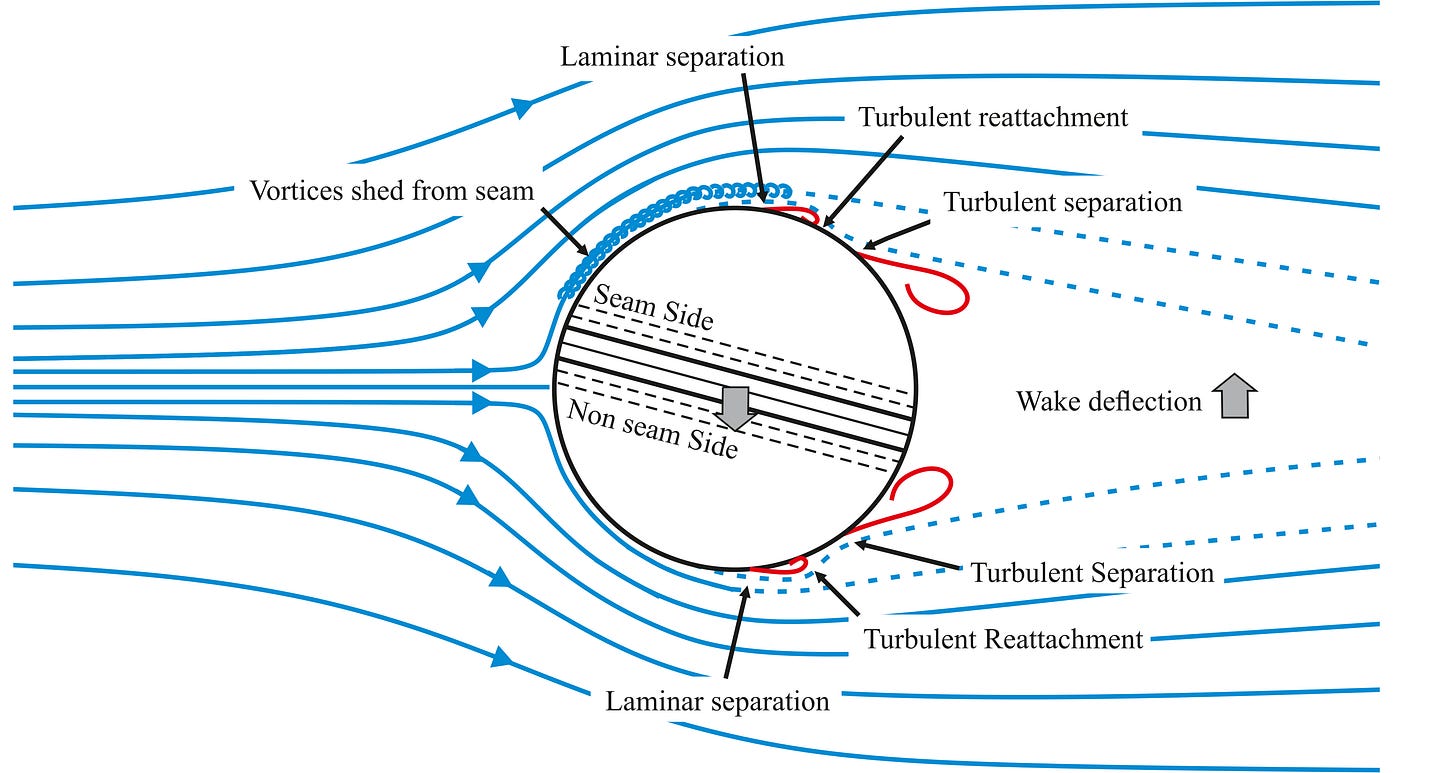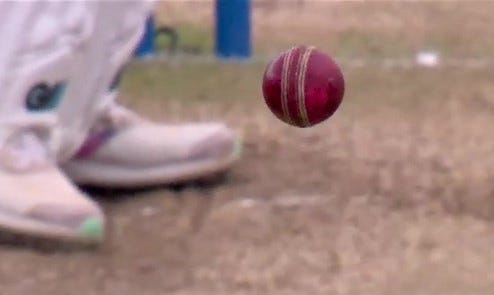Conventional and Reverse Swing - two sides of the same coin
And why Mitchell Starc is probably my favourite swing bowler to watch
Another week, another rollercoaster of an Ashes Test match, this time threatening to hit Headingley 2019 levels. While Ben Stokes turning into superman wasn’t quite enough to get England over the line, this game was again littered with amazing and controversial moments.
Sadly, I was only able to watch a grand total of one session this week (who decided that deepest, darkest Cornwall, with its stunning views, amazing weather, incredible food and terrible phone signal made a good wedding location??), so I can’t really review the match properly; if you want to read about the ‘downfall’ of Bazball, or The Spirit of Cricket™ , head to your nearest national newspaper or respectable cricket blog.
Instead, I thought I would try something different, and use a few moments from the match to highlight specific aspects of The Science of Swing, and talk about one of cricket’s most interesting swing bowlers, Mitchell Starc.
“I tell you what, that looked like a half-volley at leg stump that he missed. I don’t think there is any swing, is there? There’s no swing!” - Shane Warne, first ball of the 2021/2 Ashes
This article is about the aerodynamic complexities of swing bowling, and an introduction to the most interesting part of my research, Reverse Swing. There will be a decent chunk of aerodynamics, along with a healthy dose of six-foot-six left-arm rockets to keep you interested.
The other side of the cliff-edge
My Ashes preview post outlines the basic aerodynamics of Conventional Swing, where the ball swings in the same direction as the seam is pointing. Before going on, it might be worth re-reading that section to familiarise yourself with the terminology I am going to use here. I’ve reposted the diagram from that post below for reference.
The key feature of Conventional Swing is that the non seam side of the ball maintains laminar flow, so that there is a contrast with the flow on the seam side, leading to a sideways force acting on the ball. No laminar flow, no Conventional Swing, as simple as that.
On the seam side of the ball, the protrusion of the seam from the surface creates turbulent flow, making the air close to the ball re-attach after separating, and stick to the ball for longer. For a new ball, this is how the seam is used to generate different airflow on either side of the ball and make it swing.
The other main point from the previous post is that swing exists near an aerodynamic cliff-edge, where small changes in the airflow around the ball, such as changes in speed or air properties, can drastically impact the swing that is generated. The reason for this lies in the nature of laminar flow around a cricket ball, and what happens when you ‘lose’ it, or, to put it in more technical language, when the airflow transitions from laminar to turbulent.
I’ll focus more on how that happens later, but after transition on the non seam side, we see a similar flow pattern as the seam side. The airflow close to the surface stays attached for longer, rather than separating from the ball near the middle. Therefore, the different airflow on either side of the ball is lost causing a large drop in the force on the ball, and the amount it swings.

The most interesting thing that happens in this case is that the ball doesn’t completely stop swinging. Using a wind tunnel, we can measure the forces on the ball while looking at the airflow around it. When the non seam side transitions, the ball actually generates a small amount of Reverse Swing, as show in the diagram above. This happens because the airflow on the non seam side now separates later than the seam side, rather than earlier.
This new ball Reverse Swing is too small to see for a normal cricket delivery, so the ball often appears to simply travel straight. However, the fact that when a ball stops swinging conventionally, it actually starts reversing is really important! This is the main takeaway from this piece, that Conventional and Reverse Swing aren’t two separate, mystic creatures, but actually two sides of the same coin, linked by what happens on the non seam side of the ball.
There are loads of factors that cause the transition which stops a ball swinging conventionally, but these are a topic for another time, as is how you get the ball reversing a long way. Understanding these ideas requires a deeper dive into the fluid mechanics of laminar and turbulent flow, so I’ll save that for a future post.
For now, let’s jump back to Lord’s and see how some of this science impacted on what happened in the 2nd Test. I promise that is the bulk of the aero content for this article, so feel free to stop taking notes/start paying attention (delete as appropriate).
Half-volleys on leg stump with a new ball
The immortal commentary from the late, great Shane Warne of the first ball wicket in the 2021/2 Ashes highlights why Mitchell Starc is so fun to watch. Starc is one of the most aggressive new ball bowlers around, both with his pace and how he swings the ball, making every spell box-office viewing, especially for swing bowling nerds like myself.
The key factor in his aggression is the length he bowls. Full. At the stumps. 90+ mph. Massive swing. Bails flying. See ya later. Just watch the Pope wicket below for a taste.
The advantage of bowling full is that it gives the ball more time to swing. I’ve talked about how fuller balls swing more, and so Starc gives himself the best chance to find any lateral movement on offer. Sometimes this length results in an easy clip off the pads, other times it’s an impossible-to-play, toe-crushing, in-swinging yorker. Either way, it’s fun to watch.
When the ball is new and shiny, it is possible to bowl at high speeds while staying below the cliff-edge of the laminar-to-turbulent transition on the non seam side. This is why you see fast, swing bowlers like Starc perform so well with the brand new ball, when they can use both pace and conventional movement. Here’s another video example, with Starc swinging the ball a long way at 88mph in the 3rd over, only to be denied on review - you can see the shape of the trajectory from Hawkeye.
As well as the ball being new, Starc’s seam position is also important. Like most left-arm quick bowlers, his natural swing direction is into a right-handed batter. This is because his slightly sling-y action means his wrist comes down the left-hand side of the ball, angling the seam to Fine Leg. While his seam isn’t as stable as someone like Jimmy Anderson, he often imparts a large enough angle that the seam doesn’t flip sides during the delivery if there is some wobble - you can see that in the Pope dismissal.
Rather than swing the ball away as a variation, he instead uses a larger wobble seam to make the ball go straight across a right-hander. For this type of delivery, the seam disrupts the laminar flow on both sides of the ball, stopping his usual large swing - watch for the difference next time he plays.
Swinging it both ways… in the same delivery?
Okay, I slightly buried the lede here, there was one delivery from the 2nd Test in particular that I wanted to talk about, but there was some useful set-up in the rest of the article. Have a look at the first highlight in the video below, where Ben Stokes is given out LBW before reviewing. Watch closely in the slow motion replay and look for which way the ball is swinging.
The hint is in the title, but I’ll break down what is happening. The ball is 37 overs old, and has developed a rough and shiny side. Starc sets up to bowl his stock ball, which would swing away from Stokes with a new ball. He releases it at 88mph.

The ball is old enough that as it is released, it starts to Reverse Swing to the left, away from the seam side. Then something strange happens. It stops swinging left, and begins moving to the right. The delivery climbs back up the cliff-edge, meaning that it starts swinging conventionally mid-flight. It ends up travelling pretty straight when it bounces, but has a slightly ‘S-shaped’ trajectory. See if you can spot it now.

This delivery is cool (very cool - Sam G) because it demonstrates exactly what I was talking about earlier, how Conventional and Reverse Swing are intrinsically linked and small changes in airflow can cause big differences in how a ball swings. Here, the flow over the non seam side goes back to laminar from turbulent as the ball slows down in the air, and the delivery is full enough that we have time to see it swing in the opposite direction. This is a super rare phenomenon which I’ve not seen before, and I watch far too much cricket!
It also shows how the speed of a delivery impacts the swing. If this ball was a bit faster, it would have stayed past the cliff-edge, and reversed a bit to the left. If it was a bit slower, it wouldn’t have reached the cliff-edge and we’d have seen conventional swing to the right, indeed, this is what happens with the very next ball. We are just lucky here that Starc hit the exact range where transition occurs and we get to see both sides in the same delivery.
If nothing else, I hope this post has made you keen to watch swing bowling more closely in the upcoming Test, though we may be in for 450 overs of bouncers given how the last match went. Either way, let’s all hope that England can keep the series alive and get back to winning ways. I’d definitly take a slightly more mundane match with an England victory - my nerves need a rest! Feel free to comment any questions below, and I hope to be able to write something else soon. Go well!



That ball to Stokes is amazing, incredibly well-spotted. Looking forward to the analysis of significant reverse swing. Might be worth restating in this article that the "cliff-edge" is related to the speed of the delivery?